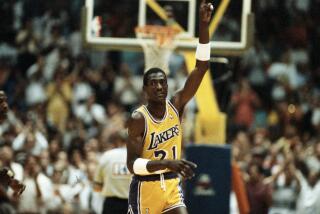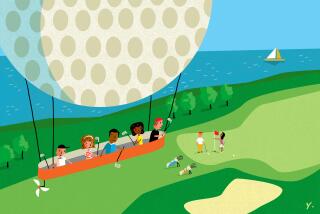The Money Was Right. . . FOR THE TIME : Harry Cooper, Who Won the First L.A. Open in 1926, Earned $3,500 for the Title--Biggest Purse of His Career
- Share via
Eight players tied for 38th place in last year’s Los Angeles Open, each earning $4,000.
“Lighthorse” Harry Cooper won the first L.A. Open in 1926, earning $3,500.
“That was the largest purse I ever won,” said Cooper, whose playing career spanned a quarter of a century.
Cooper, now 86 and still teaching golf at the Westchester Country Club in Rye, N.Y., was one of the most celebrated players of his era.
Even with inflation, Cooper calls the money that is available for the touring pros “unbelievable.”
For example, Cooper won seven tournaments in 1937, earning $14,138 as the leading money winner for the year .
During his career he won 30 tournaments, finished second 37 times and had 205 top-10 finishes.
Yet his career earnings would be a mere pittance by present-day standards. Tom Kite has 15 fewer tournaments titles than Cooper, but Kite is the all-time leading money winner with earnings of more than $6 million.
“I’d just like to have what they’re getting today,” Cooper said. “They’ll get $25,000 to $50,000 for one of those (corporate) outings.
“I went to Australia in 1934 with a six-man team. We spent six weeks there and were lucky to break even although our expenses were paid.”
Cooper played in a different era, before corporate sponsorship and televised events. Yet in context, he ranks among the best who played.
In addition to his 30 victories, he was the first winner, in 1937, of the Vardon Trophy based on the lowest scoring average for the year.
Cooper got his nickname during the 1926 L.A. Open at the Los Angeles Country Club.
The sponsoring Junior Chamber of Commerce offered a total purse of $10,000, lucrative at the time, in order to lure pros from the East and Midwest to California, which hadn’t had any major golf events.
The tournament also attracted Eastern sportswriters Damon Runyan and Ring Lardner.
It was a 36-hole format for the final day of the tournament, and Cooper was paired with amateur George Von Elm.
“He shot 67 in the morning and I had a 74, so we were even and leading the field,” Cooper said. “We played the last 18 holes in 2 1/2 hours and that’s where I got my nickname, Lighthorse Harry Cooper, from Damon Runyan.”
Cooper beat Von Elm by three strokes and came back the next year to defend his championship at El Caballero Country Club in Tarzana.
“It was out in the wilderness then, a lot of snakes,” Cooper said. “I remember that I got ptomaine poisoning before the final round after leading the first two rounds.”
It wasn’t until 1937 that Cooper won the L.A. Open for the second time. He did it at Griffith Park, a municipal course, winning by five strokes.
“I only got $2,500 for winning then,” he said. “I was on the tour tournament committee and I thought the prize money was too top heavy and should be spread out.”
Even though he won the L.A. Open twice and finished second in 1928, Cooper has some painful memories of the event.
First it was ptomaine poisoning, then he injured his hand--by dancing.
“I played 14 rounds before the 1940 tournament at Riviera and averaged 68 a round,” Cooper said. “Then, I couldn’t play.
“My wife and I were taking a rumba lesson and, when we became parted, she grabbed for my hand and cracked my thumb. Fortunately, I had an accident policy that paid me as much as I would have won if I finished second in every tournament.”
Cooper was in his prime as a player in the mid-1930s, an era that included such notables as Gene Sarazen, Horton Smith, Paul Runyan, Craig Wood, Ralph Guldahl and Tommy Armour.
Yet he is often remembered for losing two U.S. Open championships that he seemingly had won.
His first disappointment came in 1927 at the Oakmont Country Club in Pennsylvania.
“We didn’t have leader boards in those days, so I didn’t know what was going on behind me,” Cooper said. “On the 17th hole, I had a downhill putt of about 12 feet and I thought I needed it.
“I went for it and it rimmed the cup. I would have been better off if I missed the hole altogether because the ball was now farther away. I three-putted the hole and then Armour, playing behind me, knocked in a 20-footer to tie me on the last hole.
“Somebody quoted me as saying, ‘I hope he holes it, so I can show him that I can beat him the next day.’ I was actually saying, ‘Miss it, miss it.’ ”
For good reason. Armour beat Cooper the next day in an 18-hole playoff.
In 1936, Cooper shot a 72-hole total of 284, an Open record, at Baltusrol Golf Club in Springfield, N.J.
“The record only lasted 30 minutes,” he recalled.
While he was receiving congratulations as the apparent winner, Tony Manero was still on the course and making a move. He beat Cooper by two strokes, breaking the Open record at 282.
“Actually, the gallery cost me the tournament,” Cooper said. “The 16th hole was a par-three and there was a big crowd following me. They were standing in between the traps and around the green. I kept waiting for them to move, but there were no gallery marshals then, no ropes. So I said, ‘To heck with it,’ and hit the ball. It hit someone up at the green and bounced into a trap. I would have been on the green.
“I took a four there, got my par at 17 and then hit two fine shots at 18. I was 40 feet from the hole in two.
“I waited for eight minutes for my playing partner to get to the green. Someone had picked his pocket. I probably got a little nervous and three-putted the damn thing. Manero got a three on the hole and beat me by two strokes.
“I could have signed up for $50,000 in endorsements before I left the club if I had won.”
Cooper was also second in the Masters in 1936 and 1938. So a major championship eluded him.
He never played in the British Open. “You had to go by ship and it was a week over, a week to play, and then a week to get back. If you won, you got only $300 and I was making more than that in one day with exhibitions.”
Cooper was born in England and came to the United States when he was 17. He lived in Dallas and won his first tournament, the Galveston Open, in 1923. He also won the Pebble Beach Open in 1927, long before the tournament was identified with Bing Crosby.
He said he couldn’t represent the United States on the Ryder Cup team because he was born in England, even though he became an American citizen.
Cooper became a club professional near the end of his playing career. He worked for five years in Hawaii and another five at Lakeside Golf Club in Toluca Lake before he settled in at the Metropolic Country Club in White Plains, N.Y., for 26 years.
He was amused to read that Arnold Palmer said that he would have won many more tournaments if he had the equipment available to present-day players.
“What does he think we were playing with in the ‘20s and ‘30s?” Cooper said.
Cooper and his wife, Emma, recently celebrated their 61st wedding anniversary.
They didn’t dance the rumba.
More to Read
Go beyond the scoreboard
Get the latest on L.A.'s teams in the daily Sports Report newsletter.
You may occasionally receive promotional content from the Los Angeles Times.









